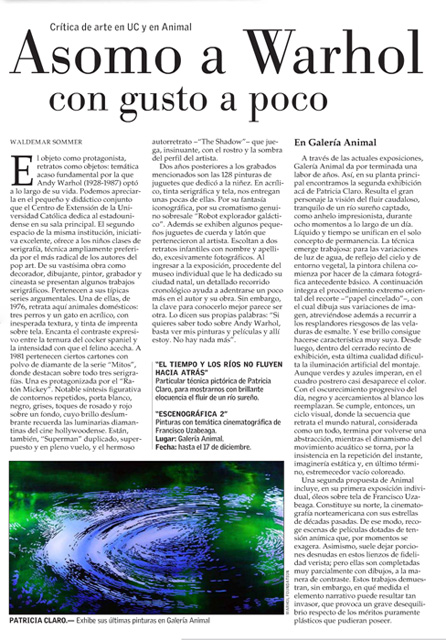A hint of Warhol left wanting more
Art critique in UC and Animal
WALDEMAR SOMMER
The object as a protagonist, portraits as objects: fundamental subject matter which Andy Warhol (1928-1987) chose throughout his life. We can appreciate it in the small and educative set that the Extension Center of Universidad Católica is dedicting to the American in its main hall. The second space from the same institution, excellent initiative, offers silkscreen classes to children, technique preferred by the most radical authors of pop art. From his vast work as a decorator, designer, painter, printmaker and filmmaker, some screen print works are presented. They belong to his typical plot series. One of them, from 1976, portrays domestic pets: three dogs and an acrylic cat, with unexpected texture and printing ink on canvas. The expressive contrast between the tenderness of the cocker spaniel and the intensity with which the cat stalks enchants. From 1981 belong some cartons with diamond dust from the series “Myths”, where three serigraphs specially stand out. One is led by “Mickey Mouse”. A notable figurative synthesis of repeated contours, with white, black, gray, touches of pink and red on a background whose dazzling brilliance is reminiscent of the diamond lights of Hollywood cinema. There are also “Superman” duplicates, overlapping and in flight, and beautiful self-portrait –“The Shadow”- that plays, insinuatingly, with the face and the shadow of the artist’s profile.
Two years after the mentioned engravings are the 128 paintings of toys that he dedicated to childhood. In acrylic, silkscreen ink and fabric, he gives us a few of them. Through his iconographic fantasy, with his genuine chromaticism, “Robot galactic explorer” stands out. Some small rope and brass that belonged to the artist are also exhibited. They escort two children’s portraits with name and last name, excessively photographic. Upon entering the exhibition, from the individual museum that his hometown has dedicated to him, a detailed chronological route helps to delve a little deeper into the author and his work. However, the key to knowing him better seems to be another. His own words say it: “If you want to know all about Andy Warhol, it is enough to just look at my paintings and films and there I am. There is nothing else.”
In Galería Animal
With the current exhibitions, Galería Animal terminates a labor of years. Like this, in its main floor we can find Patricia Claro’s second exhibition here. The great character turns out to be the vision of the mighty, quiet flow of a Southern river caught, like an impressionist longing, for eight moments throughout a day. Liquid and time are unified in the sole concept of permanence. The technique emerges elaborately: for the varations of the light of water, the reflection of the sky and the vegetation surroundings, the Chilean painter begins by making the photo camera a basic precedent. Then she integrates the extremely oriental procedure of cutout –“chiseled paper”- with which she draws her image variations, daring also to resort to risky glares of enamel glazes. And that glow turns into a characteristic very much of herself. Of course, within the display enclosure, this latter characteristic makes the artificial lighting assembly difficult. Although green and blue prevail, in the last painting the color almost disappears. With the progressive darkening of the day, black and approaches to white replace them. A visual cycle, then, is completed. Where the sequence that portrays the natural world, considered as a whole, ends up becoming an abstraction, while the dynamics of water movement turns, through the insistence of the repetition of the moment, into static imagery and ultimately, into a shocking colored emptyness.
A second proposal of Animal includes, in its first solo exhibition, oil paintings on canvas of Francisco Uzabeaga. It constitutes its north, an American cinematic with its stars of past decades. Through this, it collects scenes from movies filed with animic tension that is at times exaggerated. At the same time, he usually leaves bare portions in these canvases of verified fidelity; but they are partially completed with drawings, as a contrast. These works show, however, to what extent the narrative element can be so invasive, that it causes a serious imbalance of the purely plastic merits they may possess.
“Time and rivers do not flow back”
Particular painting technique Patricia Claro, to show us with brilliant eloquence the flow of a southern river.
“Stage 2”
Paintings of cinematic theme by Francisco Uzabeaga cinematic theme.
Location: Galería Animal.
Date: until December 17.

